The pressure is real. Stakeholders ask you to hit aggressive targets, fill the marketing funnel fast, and prove return on investment (ROI).
They often measure ROI with one simple metric: cost per lead (CPL).
But a low CPL doesn’t always mean high performance. It creates a false sense of success. If most leads don’t convert, you waste your already limited budget. Since 80 percent of leads never turn into sales, you’re left with inflated metrics and frustrated teams.
The ultimate goal goes beyond generating leads. It’s driving sustainable customer acquisition and long-term growth.
Instead of just looking at short-term costs, consider deeper measures of value. Think about customer lifetime value (LTV) and overall conversion health.
To see this shift in action, we spoke with Matt Linder. He’s the Co-Founder and Managing Partner at Strand Agency, a digital marketing agency that focuses on performance and partnership marketing.
Linder explains why you should look beyond surface-level metrics. He also gives actionable tips to align your teams, data, and incentives to turn your lead generation program into a growth engine.
To do this, you need the right technology in place. So we connected with impact.com’s Senior Product Marketing Manager, Matt Moore, to walk us through the capabilities needed to turn these insights into a winning campaign.
This article combines insights from Strand Agency’s performance marketing expertise with impact.com’s partnership platform capabilities to help marketers transition from cost-per-lead to lifetime value strategies.
Ahead, you’ll learn how to:
- Use impact.com to unify partnership data across multiple partner types
- Measure growth using the metrics that truly matter
- Evaluate the impact of a lead, not only its cost
- Align your teams and incentives to reach shared goals
- Future-proof your affiliate lead generation strategy for long-term success
The full-funnel performance marketing framework
To grasp why a narrow focus on CPL is limiting, we need to step back and consider the entire performance marketing framework. The backbone of any effective growth strategy.
The following framework outlines the whole customer journey. It starts when someone first discovers your brand and ends when they become a loyal, returning customer.
Each stage requires a different approach, set of metrics, and type of content to move prospects closer to conversion.
Broadly speaking, the marketing funnel can be broken down into three main stages:
- Top of funnel (TOFU): Build awareness and attract new audiences.
- Middle of funnel (MOFU): Nurture interest and evaluate lead quality.
- Bottom of funnel (BOFU): Leads convert into paying and ideally repeat customers.
When you focus only on CPL, you tend to spend too much on the top of the funnel. You’re neglecting the middle and bottom. These are the crucial nurturing and conversion stages.
And here’s the truth: these stages determine if your leads actually generate revenue.
Understanding the customer journey
The customer journey isn’t a straight line. Linder sees it as a loop, adding, “People don’t always move neatly from awareness to purchase anymore. They jump between channels, compare options, read reviews, and take their time deciding.”
Customers have instant access to information. This gives them control over how and when they interact with brands. The journey doesn’t usually end at the point of sale. It continues through repeat purchases, loyalty, and advocacy.
impact.com’s Senior Product Marketing Manager Matt Moore adds that a lead’s value is no longer about a single transaction.
Moore advises, “You should aim to build strong relationships that offer value long after that first purchase. This turns your customer’s journey from a one-time transaction into an ongoing relationship with your brand.” Focusing on this long-term view fundamentally shifts the impact of customer acquisition from short-term sales to sustainable, lasting revenue.
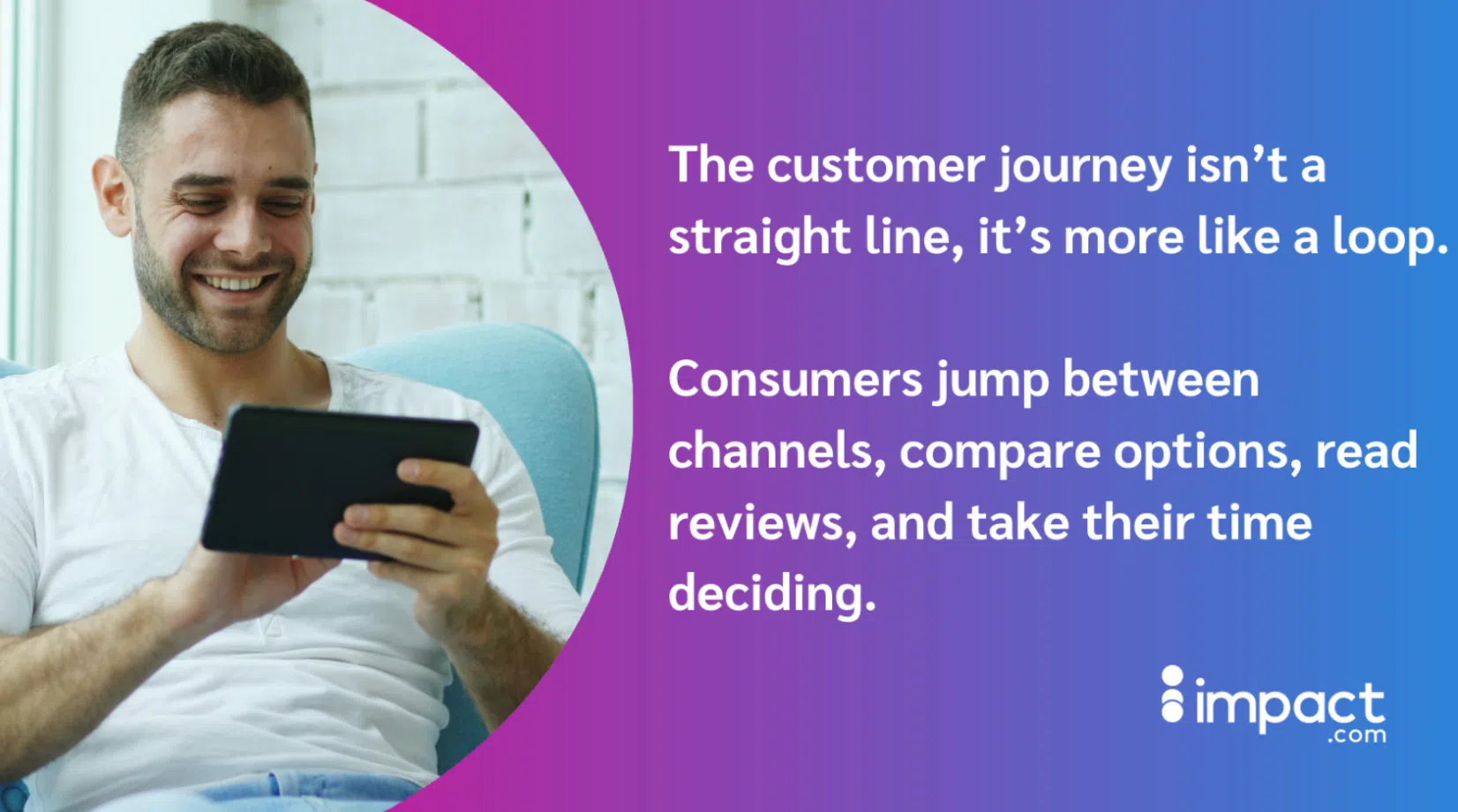
| Understanding the customer journey | |||
|---|---|---|---|
| Journey stage | Definition | Marketing goal | Strategies |
| Beginning (top of funnel – TOFU) | The customer is unaware they have a problem or that your brand can solve it. | Build brand awareness. | Content marketing, social media, and SEO. |
| Middle (middle of funnel – MOFU) | The customer is aware of their problem and is considering solutions. This is where a lead is generated. A lead is a potential customer who has provided their contact information, signaling their interest. | Capture interest and generate leads. | Forms, downloads, and newsletters. |
| End (bottom of funnel – BOFU) | The lead is ready to make a purchase. | Convert the lead into a paying customer. | Targeted offers, sales calls, and affiliate programs. |
CPL vs CAC: The metrics that matter
Now that we’ve mapped the customer journey, you can see how different metrics connect. This also shows why focusing on just one can be misleading.
Cost per lead (CPL) sits in the middle of the funnel. It shows how much you spend to get a potential customer’s contact info. Think emails or form submissions. It’s useful for tracking the efficiency of your lead generation efforts, but it only tells part of the story.
Customer acquisition cost (CAC) covers the entire journey. It measures the total cost of turning a lead into a paying customer, including:
- Marketing
- Sales
- Operational expenses
When you focus solely on CPL, it’s easy to mistake volume for value. A low CPL might look good on paper, but if those leads never convert or stick around, they’re not really driving growth.
To uncover true performance, Linder advises brands to analyze CPL, CAC, and LTV together. This shows which leads turn into profitable, long-term customers.
Why your lead generation strategy falls short
Misguided CPL focus
Generating a lead is a great start. But it’s only the beginning of the journey.
Linder puts it simply. “You’ve got a story to tell to that person who has raised their hand that they’re interested in learning more about your business.” The best way to do this is to create valuable, relevant content for your audience. If they downloaded a product guide, follow up with a customer success story.
This approach ensures you’re engaging with genuinely interested prospects, rather than solely focusing on the quantity of leads.
There’s an important nuance here: Not all leads are created equal. Some are genuinely interested and go through a detailed qualification process. Others might sign up for an incentive or freebie. When you focus only on CPL, these differences get lost. And that’s where problems begin. A narrow CPL focus creates several issues:
- Misallocation of budget: You end up funding channels that deliver “cheap” leads instead of those that drive higher-value customers.
- Incomplete measurement: Downstream costs like retargeting, nurture campaigns, and direct mail get ignored.
- False confidence: Teams celebrate hitting CPL targets without asking whether those leads actually convert, renew, or contribute to long-term growth.
Moore emphasizes that ignoring these downstream factors is a classic blind spot. “It’s not always easy to measure downstream metrics, but they’re where true costs hide,” he explains. “If you can’t measure retention, renewals, and upsells across all your partnerships, you’re missing key components.”
The next step after knowing which metrics to measure, Moore adds, is implementing the right tech stack: “Technology like impact.com’s unified partnership platforms connects that CPL event right through to the final closed deal, helping you optimize your program.”
At its core, CPL is just one piece of the puzzle. Without layering in metrics like conversion rate, customer value, and retention, you might optimize for efficiency instead of true effectiveness. It’s easy to chase short-term wins while missing long-term revenue.
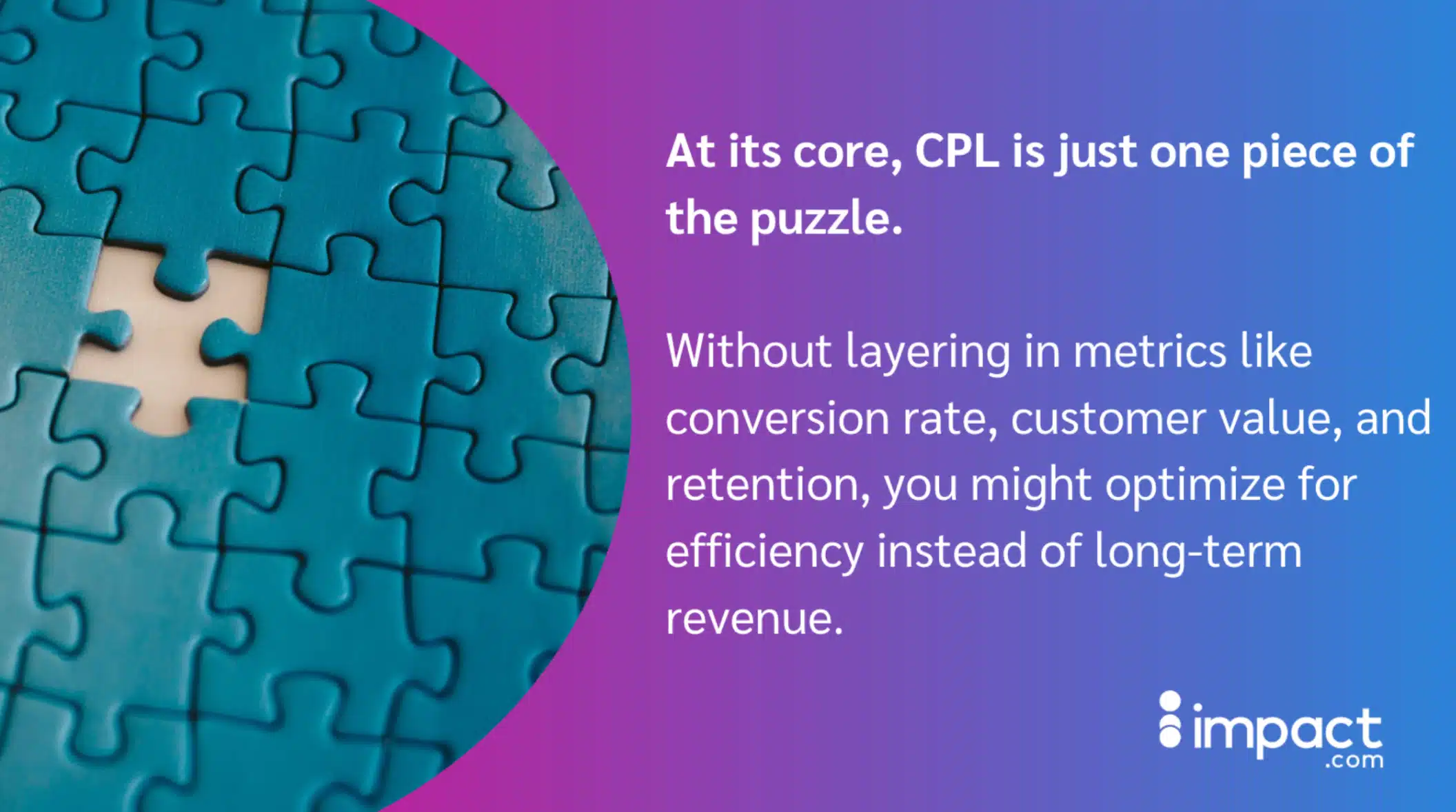
False sense of success: A case study
One major membership organization Linder worked with seemed to be winning. They were generating around 500,000 new leads monthly, all at under $0.50 per lead. On paper, it looked like a huge success.
But when the Strand team looked closer, the numbers told a different story.
- The organization didn’t track LTV beyond the initial signup.
- Renewal rates were far lower than other channels.
- Most leads did not convert into multi-year, high-value memberships.
In short, the client optimized for cost, not quality. The brand celebrated reaching its volume target. However, those leads didn’t lead to real growth.
Strand’s solution: Building quality-first data infrastructure
The Strand team stepped in as the essential expert consultant, recognizing the immediate need for a quality-first approach.
Key actions and deliverables:
- Data partnership: Partnered directly with the client’s internal Business Intelligence (BI) and data team.
- Crucial tracking: Implemented a new mechanism ensuring every lead was tagged appropriately.
- Downstream performance: This allowed for accurate tracking of performance, from acquisition through to multi-year renewal.
- Marketing alignment: Helped build a comprehensive internal email drip series.
- Integrated strategy: Worked with the print team to synchronize drop dates with digital touchpoints.
Result: This holistic approach successfully turned mere activity into actionable, measurable growth.
Key takeaway: Cheap leads aren’t always good leads. Without experts like Strand to link early metrics like CPL to long-term results such as conversions and renewals, it’s easy to confuse activity with genuine success.
How high-quality partnership marketing drives lead qualification
It’s time to rethink a common misconception Linder hears all the time: Not all lead publishers are bad. You may think that publishers sell the same leads to several competitors. But that’s only true for some. The key is knowing how to tell the difference.
There are two main types of publishers:
- The “race to the bottom” publisher
- The high-quality partner
The “race to the bottom” publisher (high volume, low quality)
- Focus: Lead volume.
- Method: Sells the same leads to several companies.
- Brand outcome: Forced to compete fiercely on speed and response time.
- Overall experience: Poor for both you and the consumer.
The high-quality partner (qualified leads)
- Focus: Lead quality and qualification.
- Method: Acts as a filter and asks detailed questions to understand intent and fit before passing on a lead.
- Brand outcome: Leads are genuinely interested and more likely to convert.
- Overall experience: Better leads, higher conversion potential.
Why your brand should pursue high-quality lead partners
- Higher conversion rates: Stronger intent means a greater chance of a sale.
- Save time and money: Publishers handle early screening, so your team can focus on real prospects.
- Better brand alignment: You get leads that match your audience, tone, and goals.
Key takeaway: Don’t judge leads by cost alone. A slightly higher CPL often signals a better-quality lead. One that’s been vetted, filtered, and ready to engage. In the long run, these leads drive more value and help you avoid the hidden costs of low-quality volume.
Actionable insight: Questions to ask and cautions to watch for
Finding the right publisher partner hinges on asking the right questions.
The main goal is to find partners who bring value, not just those who resell unqualified leads.
Six key questions to ask potential partners
Ask these questions to determine how a publisher finds, qualifies, and measures leads:
- How do you qualify your leads?
- Follow-up question: What questions do you ask consumers to assess intent and fit?
- Do you sell your leads to multiple buyers? If so, how many?
- What compliance and data security measures are in place?
- Can you share examples of campaigns where you delivered value beyond a low CPL?
- What technology or tools do you use to track and report lead quality and performance?
These questions reveal how much a partner values long-term outcomes over quick lead numbers.
Warning signs to look for in publishers
A few warning signs can tell you when a publisher might not be the right fit:
- Vague answers: If they can’t clearly explain how they qualify leads, walk away.
- Volume over quality: When “low CPL” is their main selling point, it usually means low-intent leads.
- Lack of transparency: A trustworthy partner should be open about their methods, data sources, and performance metrics.
The bottom line: Quality partners build your trust with clear data, not discounts or empty promises.
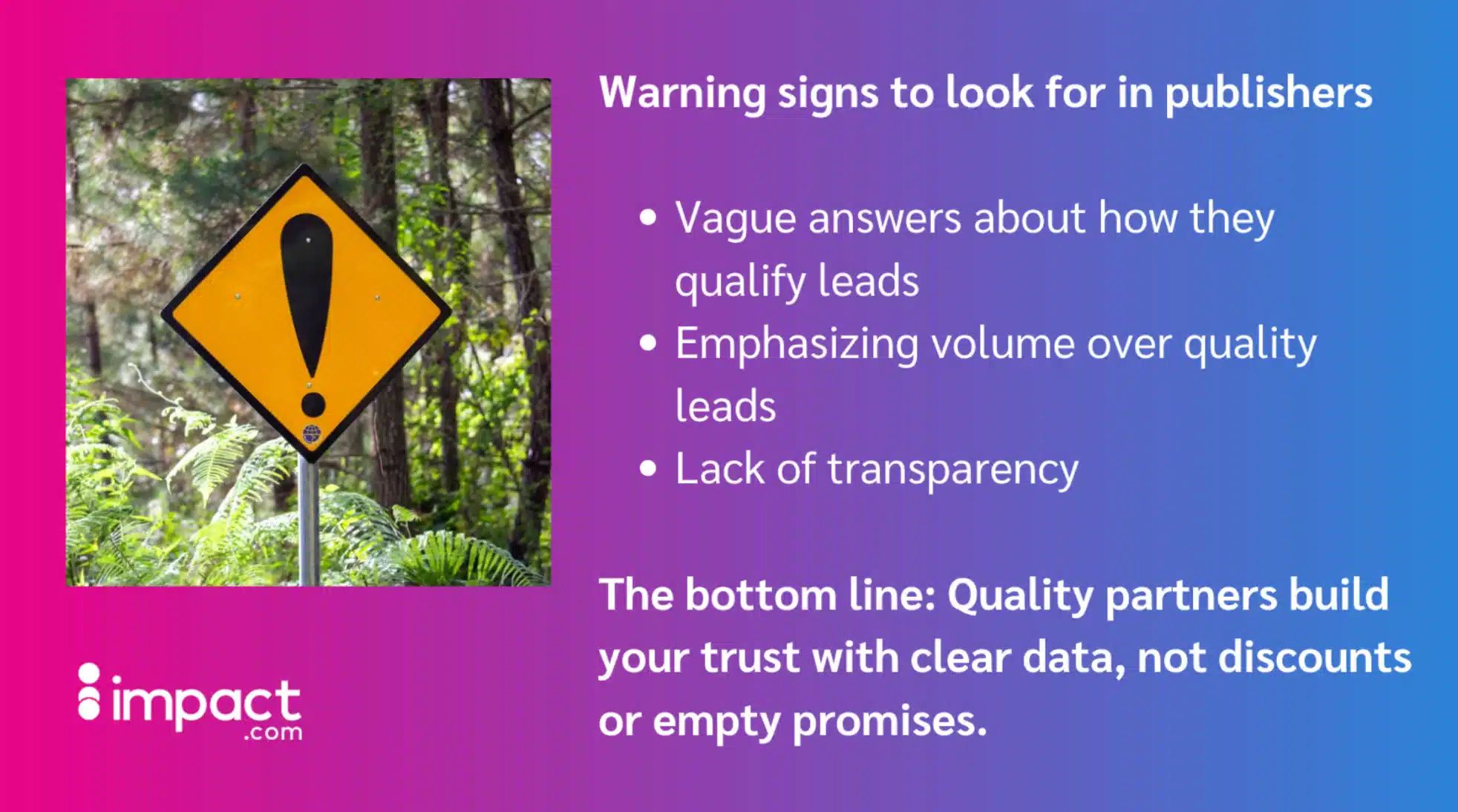
The need for placement-level verification
The primary challenge in affiliate lead generation is that publishers often use multiple content placements, ad types, and microsites, all rolling up under one “publisher ID.”
When a lead converts months later, traditional tracking can’t attribute the long-term value back to the specific piece of content that initiated the lead.
Moore highlights this opacity as the biggest killer of ROI. “If you can’t audit the sub-sources, you can’t optimize your spend. You end up paying for low-value traffic.” To solve this, you can implement technical infrastructure like impact.com’s deep attribution capabilities to audit these sub-sources and invest confidently.
Simple evaluation scorecard
Use this simple framework to evaluate potential partners and ensure you’re focusing on what truly matters:
| Identifying high-quality lead partners | |||
|---|---|---|---|
| Criteria | 1 (low value) | 3 (medium value) | 5 (high value) |
| Lead qualification process | Minimal or no pre-screening. | Basic, generic questions. | Detailed, customized questions that align with your brand’s criteria. |
| Exclusivity | Leads sold to multiple companies. | Leads sold to a few non-competing companies. | Leads are exclusive to your company. |
| Transparency | Minimal reporting; vague data. | Provides basic CPL reports. | Provides detailed reports on sub-source performance, conversion rates, and downstream value. |
| Price | Low CPL is the main selling point. | Price is average for the industry. | CPL is higher, but the publisher can demonstrate how it leads to a higher LTV. |
From volume to value: A full-funnel marketing approach for sustainable growth
Not all leads are created equal, and chasing volume alone rarely leads to long-term success. Moore adds that your goal should be building sustainable customer acquisition that delivers lasting value, not just filling your pipeline for quick wins.
That’s where a full-funnel approach comes in. By balancing your efforts across every stage of the customer journey, you can attract, nurture, and convert high-quality leads that stick around.
An agency like Strand helps your brand move from short-term lead counts to long-term growth. The expert teams approach combines strategies throughout the funnel:
- Bottom-funnel channels: Affiliate programs, native placements, and email acquisition to drive direct conversions.
- Mid-funnel strategies: Lead generation and nurturing campaigns aim to capture intent and build trust over time.
When all parts of the funnel work together, you shift from measuring quantity to measuring real value. This builds a marketing engine designed for lasting growth.
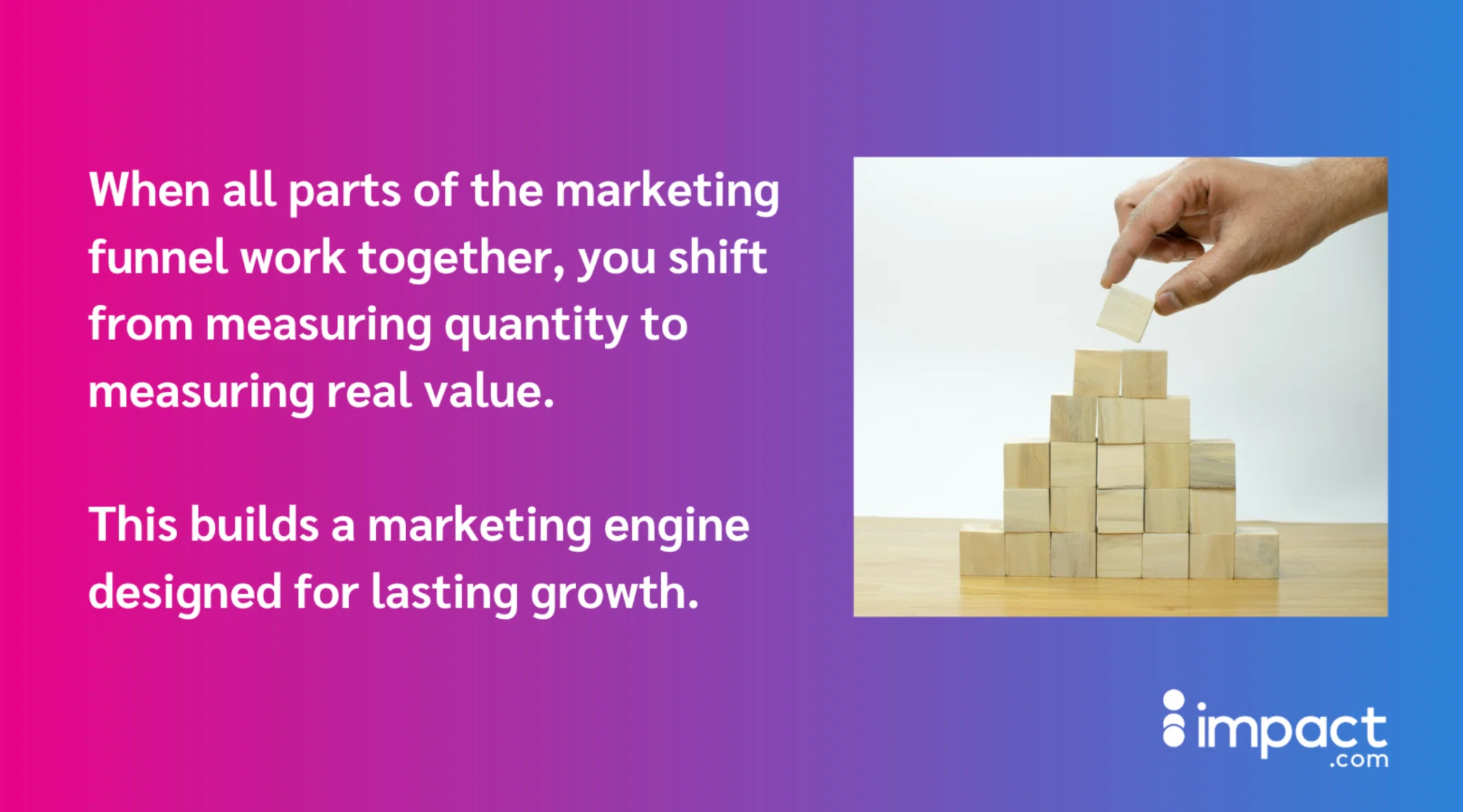
Monetizing your leads
Generating leads at scale only works if you have a strategy to monetize them. Without one, even the cheapest leads can turn into wasted spend.
To do it right, you need to understand a few key elements:
- LTV: How much each customer is worth over time.
- Remarketing costs: What you spend on email, SMS, or paid campaigns to move leads toward a sale.
- Tracking accuracy: The ability to trace each lead back to its source and measure real performance.
A low CPL only means something if it supports your broader goals. Ask yourself:
- Are these leads being tracked accurately from first click to conversion?
- Do cheaper leads perform as well as higher-cost ones in your nurture journey?
- Are they cheaper because they got incentives to sign up, making them less qualified?
- Do they deliver the same or better lifetime value compared to other channels?
When done well, lead generation can enhance your acquisition strategy and justify the upfront cost. But when measured in isolation, CPL can be misleading. What really counts is whether those “cheap” leads become valuable, loyal customers who help your business grow over time.
Beyond CPL: Shifting from lead counting to lifetime value
If your marketing strategy still defines success by CPL alone, it’s time for a new lens. CPL can tell you how efficiently you’re collecting contacts. But it can’t tell you whether those leads convert, engage, or stick around.
To build sustainable growth, you need to look past the initial click and measure what happens next. That means shifting your focus from counting leads to creating long-term value.
Diagnosing readiness
Knowing when you’re ready to move beyond simple lead counting starts with a mindset shift.
Ask yourself:
- What are my quarterly or annual goals?
- After generating a lead, what actually happens next?
- Do I have visibility into conversion rates, engagement, and lifetime value?
- Can I track leads down to the source, and even sub-source, to see which ones truly drive results?
Linder adds that once you start asking these questions, the gaps become clear. You realize that counting leads isn’t the same as creating growth. That’s when you’re ready to upgrade from tracking numbers to creating a marketing system that provides lasting value.
Measure the right metrics for growth and retention
The real story starts after a lead is captured. That’s when you find out if your marketing is helping business growth or just adding to the pipeline.
To measure true performance, focus on the metrics linked to revenue and retention:
- Engagement: Are leads opening your emails, clicking through, or responding to outreach?
- Conversion rates: How many leads are actually turning into paying customers?
- LTV: Do these customers renew, upgrade, or stay longer than others?
- Retargeting efforts: Do they engage when you use paid search, social media, or display ads?
These metrics go beyond surface-level success. They indicate whether your efforts attract loyal customers. This loyalty drives sustainable growth.
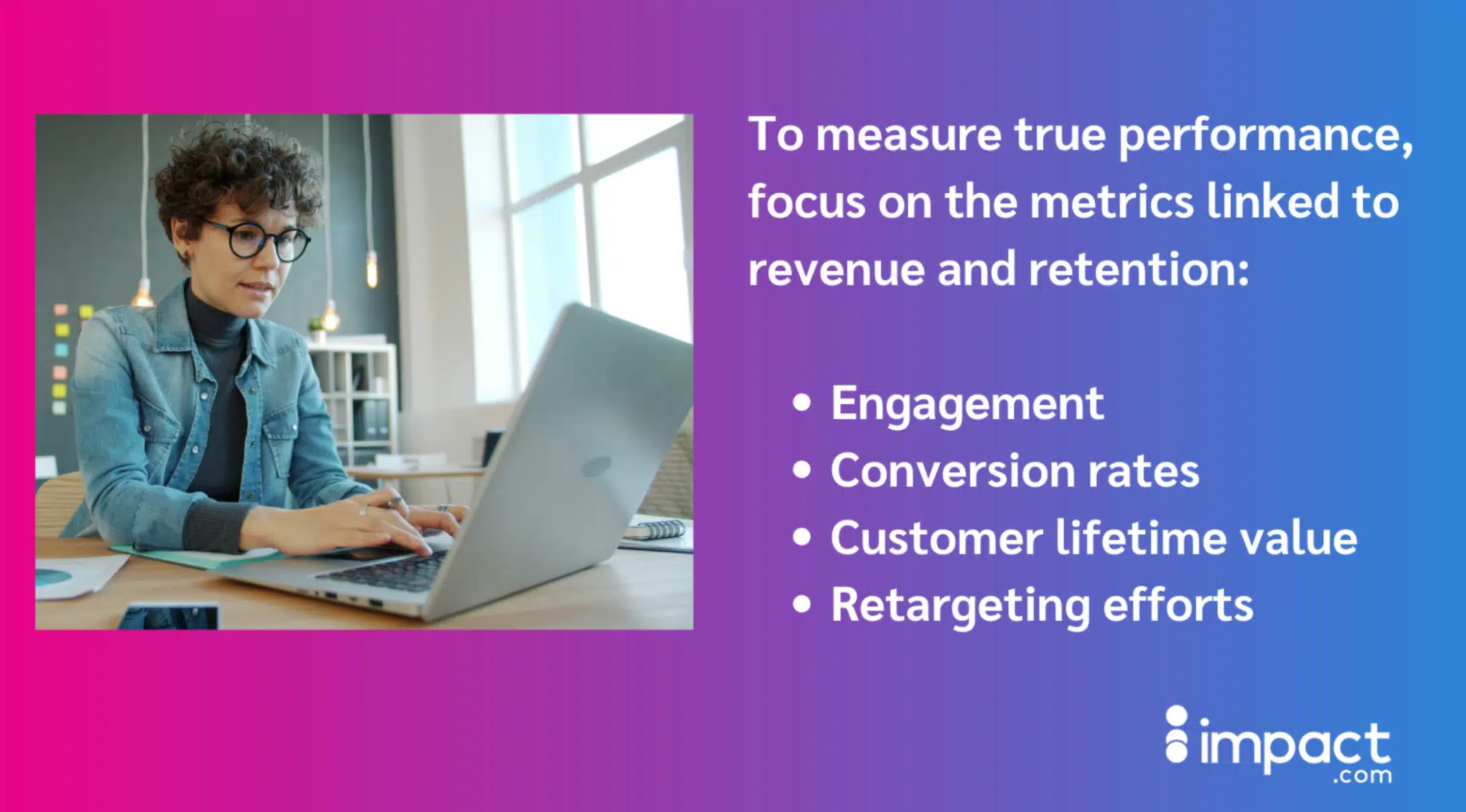
Expanded engagement metrics
Engagement no longer revolves around open rates. It includes how people show interest in your brand over time.
Think outside the inbox. The most valuable leads don’t click once and disappear; they keep showing up in meaningful ways.
Here are a few key behaviors that signal real engagement:
- Exploring your site: Reading blog posts, case studies, or product pages shows growing curiosity.
- Signing up for events: Joining a webinar or live demo suggests intent to learn more.
- Logging in or returning frequently: Whether it’s a platform, app, or streaming service, repeat visits reflect genuine commitment.
- Interacting with content: Watching videos, downloading guides, or sharing posts reveals growing interest.
Each of these actions tells part of a story, one where engagement builds trust, and trust builds conversion.
By tracking these signals, you can spot which leads are ready to move forward and who might need a little more nurturing to convert.
Checking frequency
How often should you check engagement metrics?
It depends on your business model and customer base, according to Linder. He elaborates further, “If you run a monthly subscription service, engagement should be on your radar weekly, or even daily, especially when you have a large audience.”
Regular check-ins help you:
- Spot trends early before they affect conversions.
- Catch potential drop-offs in engagement or activity.
- Act quickly to prevent small issues from turning into churn.
Key takeaway: Consistency is everything. The more often you review your data, the faster you can adapt, and the easier it is to keep customers engaged and loyal.
Measure retention and churn
Retention and churn reveal whether you’re building lasting relationships or just collecting one-time customers.
Start by tracking:
- Active churn: Customers who cancel outright.
- Passive churn: Customers who stop engaging but haven’t officially left.
Then, compare retention rates across channels.
- How does email perform vs paid search?
- Does social deliver customers who stick around longer?
If one channel’s retention is lagging, it’s a signal your strategy needs a refresh.
A cheap lead with no engagement or lifetime value costs more in the long run than a slightly more expensive lead who becomes a loyal customer.
Key takeaway: Retention is where real ROI lives. Instead of only focusing on getting more customers, you prioritize keeping the right ones.
How to measure progress six months into your new approach
So, what does “good” look like six months into your new approach? It’s about going beyond simple numbers. We need to understand lead quality and performance better.
By this stage, you should:
- Track leads to the sub-source level. This helps identify which partners and channels provide the best results.
- Understand the full lead life cycle from acquisition to conversion.
- Evaluate retention and reactivation opportunities to keep valuable customers engaged over time.
- Understand what drives sales. It could be from a paid search click, an affiliate referral, or a qualified publisher lead.
When you can connect these dots, you’re creating a system that shows where real growth comes from.
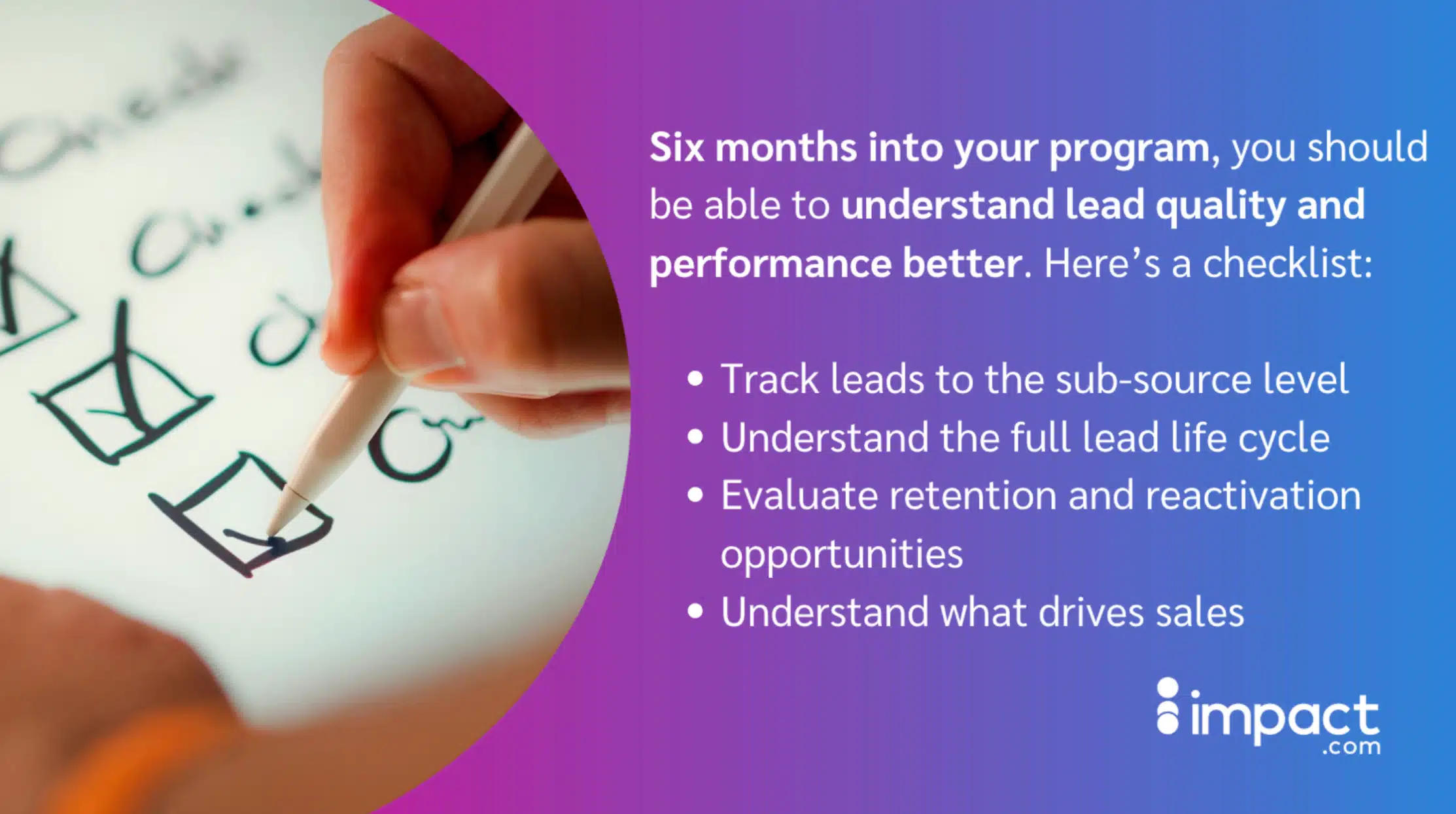
Shifting from CPL to LTV: A three-step action plan
Shifting from CPL to LTV doesn’t mean you change what you measure. Instead, you change how your teams think, work, and track success. That transition takes structure.
These three steps will help you move from theory to action:
- Tie lead generation to your company’s goals
- Use a human-centred approach to handle resistance
- Implement the right technology and infrastructure
The key is to align your goals, people, and technology around long-term growth instead of short-term volume.
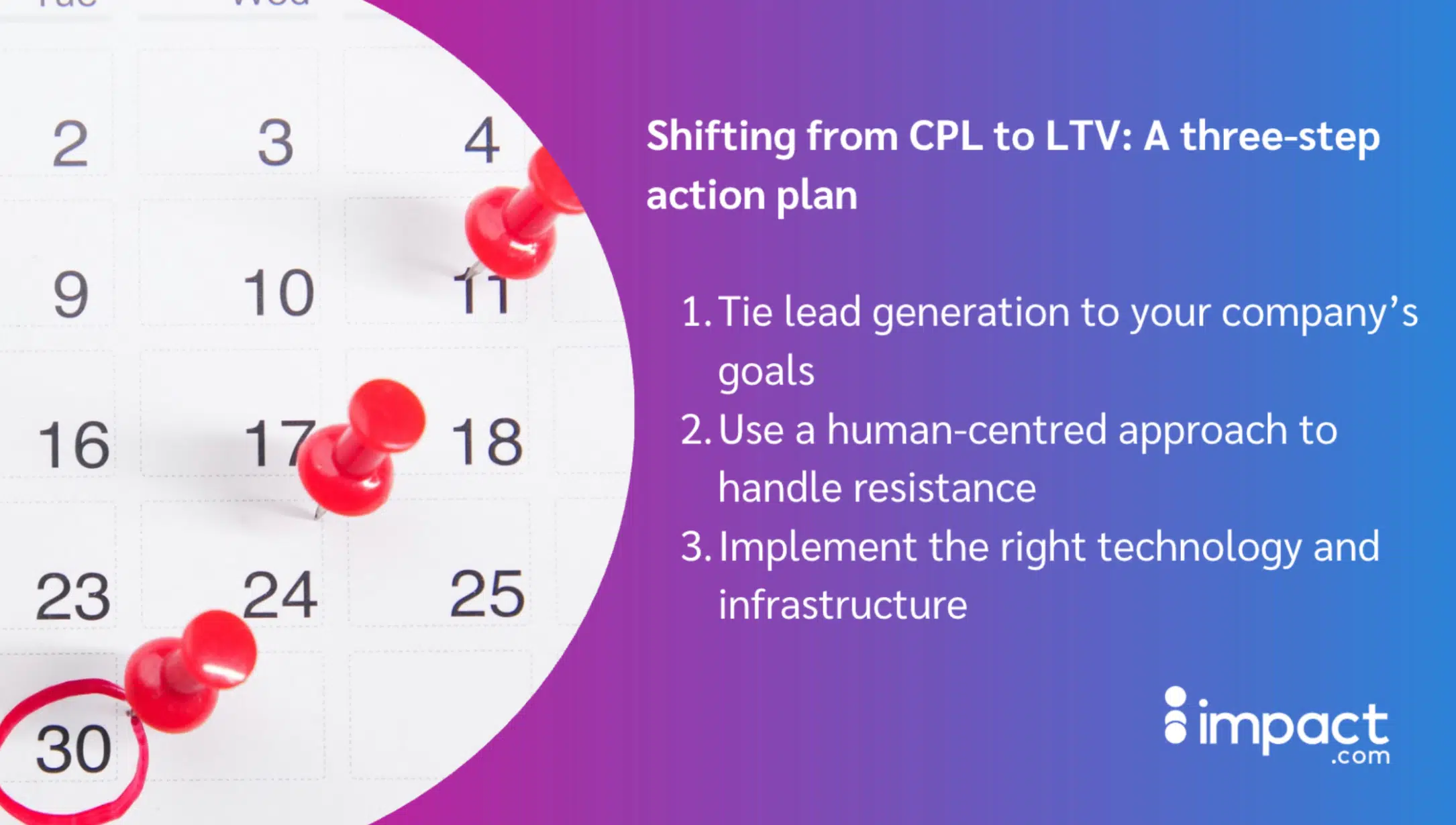
Step 1: Tie lead generation to your company’s goals
Scenario: It’s easy to fall into the trap of chasing cheap leads at any cost. On paper, a low CPL looks great, but it doesn’t guarantee those leads will convert or stick around.
Solution:
- Implement a lead scoring model
- Create a lead tracker
- Integrate data for a full-funnel view
| ❌ The trap: Low CPL | ✅ The goal: Sustainable growth |
| Looks great on paper | Real success: High conversion and retention rates. |
| False success: Pipeline is full, but leads don’t convert. | Lasting acquisition: Leads become long-term, valuable customers. |
| Focus: Efficiency (getting cheap leads). | Focus: Effectiveness (getting quality leads). |
Practical steps: Optimizing lead performance
- Segment leads: Divide by source and sub-source.
- Track performance: Monitor how each group performs (conversion, retention).
- Key insight: “Expensive” channels can bring higher-value customers who:
- Stay longer
- Spend more
Implement a lead scoring model
A lead scoring system helps you focus on the best prospects. It checks their readiness to buy, budget, and specific needs. You can assign a score based on a lead’s actions and profile, such as attending multiple webinars or downloading several resources.
Tailor the demographic and behavioural cheatsheets below to fit your business goals.
| Lead score cheatsheet: Demographic information | |||
|---|---|---|---|
| Criteria | Important questions | Description | Score |
| Job title | Is the lead a decision-maker or key influencer? | C-level executive Director/VP Manager Individual contributor | +15 +10 +5 +2 |
| Company size | Does the company’s size align with your target market? | Enterprise (1000+ employees) Mid-market (100-999 employees) Small business (1-99 employees) | +10 +7 +3 |
| Industry | Is the lead in an industry you specialize in? | Target industry 1 Target Industry 2 Other | +10 +10 +0 |
| Location | Is the lead within your service area? | Domestic/target region Not a target region | +5 -5 |
| Budget | Did the lead indicate a specific budget? This helps assess their readiness to buy. | Has a budget No budget information | +15 +0 |
| Lead score cheatsheet: Behavioral | |||
|---|---|---|---|
| Criteria | Important questions | Description | Score |
| Website activity | How engaged is the lead with your website? | Visited a pricing page Visited the “Contact Us” page Visited the website multiple times Visited a single page | +10 +10 +5 +1 |
| Content downloads | What content did the lead download? | Case study or whitepaper Ebook or guide Downloaded several resources | +10 +5 +15 |
| Form submissions | What forms did the lead fill out? | Requested a demo/consultation Signed up for a webinar or attended multiple webinars Subscribed to a newsletter Downloaded a free template | +20 +10 +5 +3 |
| Email engagement | How responsive is the lead to your emails? | Clicked a link in an email Opened an email Unsubscribed | +5 +2 -10 |
Create a lead tracker
Start simple. Use a spreadsheet or lead tracking template to monitor where each lead comes from and how it performs over time.
Tracking this information helps you:
- See which channels deliver the best leads
- Stay on top of follow-ups and priorities
- View overall pipeline health
Even a basic tracker gives you visibility and helps you move from guesswork to informed decisions.
Integrate data for a full-funnel view
Next, connect the dots. You need visibility into conversion rates, engagement, and LTV across your entire funnel. impact.com’s full-funnel tracking capabilities are essential for this, allowing you to track leads to the sub-source level to pinpoint exactly which specific placements are driving your highest-value customers.
Key takeaway: The goal isn’t to ignore CPL. It’s to put it in context. CPL is one input in a much bigger equation. Real value comes from knowing CAC and LTV. These metrics reveal if your leads become profitable, long-term customers.
Step 2: Use a human-centred approach to handle resistance
Scenario: Change often meets resistance. Especially when the current system looks like it’s working. If your teams are measured on low CPL and high lead volume, they’ll naturally be hesitant to shift their focus.
That pushback usually comes from misaligned incentives. One team is chasing volume. Another is chasing revenue. And no one’s fully aligned on what “good” really means.
Solution:
- Align incentives and goals between teams
- Use a human-centred approach to guide the transition
Strategies for sustainable growth: Quality, data, and aligned incentives
Gather your key stakeholders from marketing, data, and growth departments.
Align them around one goal: attracting the most valuable customers, not just the most leads.
This may require organizational change, not just new metrics. Use a simple change management framework to guide the process:
- Communicate the “why.” Explain how quality over quantity leads benefit everyone.
- Show the data. Highlight how focusing on LTV and CAC improves long-term ROI.
- Align incentives. Update KPIs to reward the behaviors that lead to sustainable growth.
When everyone has the same goal, pushback becomes progress. Your teams then focus on impact, not just activity.
Moore says that for these organizational goals to stick, the data must be uniform: “Aligning incentives is easy on paper. But only a centralized, unified platform like impact.com can ensure sales, marketing, and finance are all looking at the same LTV number and rewarding partners based on actual business contribution, not just front-end CPL.”
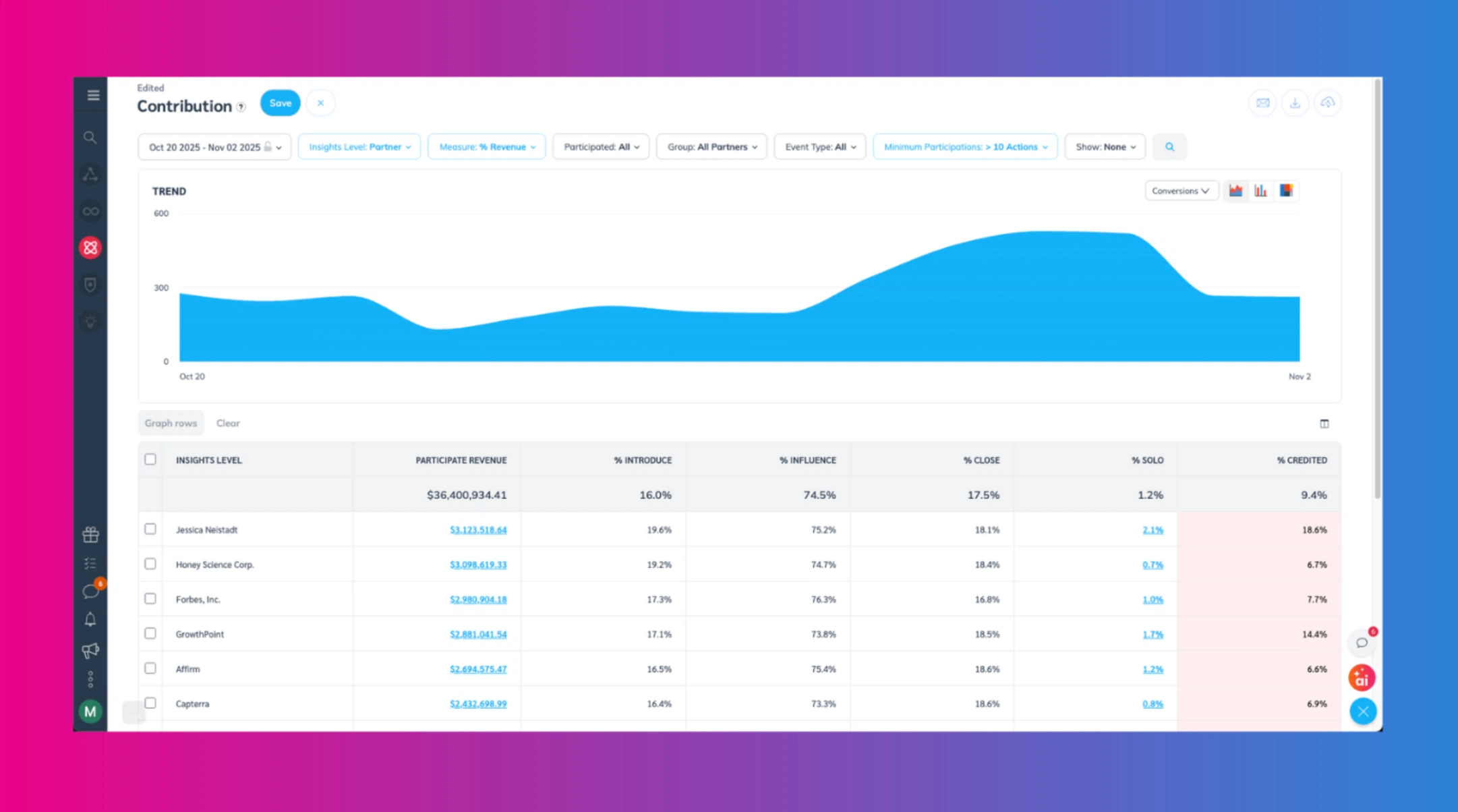
Monitoring partner contributions has never been easier with impact.com. Gain real-time insights for your most important metrics.
Guiding change with ADKAR: A human-centered approach
The ADKAR model is a straightforward, goal-focused framework. It guides teammates through change, step by step. It focuses on the individual journey, not just the organizational process.
This model is built around five key building blocks:
- Awareness: Understanding why change is needed.
- Desire: Wanting to take part and support the change.
- Knowledge: Knowing how to make the change happen.
- Ability: Having the skills and tools to follow through.
- Reinforcement: Making sure the change sticks long term.
Using ADKAR helps you address resistance at the human level. Instead of pushing change from the top down, you help each team member feel prepared, capable, and supported.
Key takeaway: Instead of complicating things, you can connect the dots across departments. When teams know the “why” and share their goals, pushback goes away. Everyone then works towards a common purpose.
Step 3: Implement the right technology and infrastructure
Scenario: Even the best strategy falls flat without the right tools to support it. Without key capabilities, transparency breaks down and optimization stalls.
Solution: To make the shift from CPL to LTV work, you need a partnership platform like impact.com that connects data, partners, and performance in one place.
When you commit to moving past CPL, you are fundamentally changing your strategy from tactical spending to investing value.
Moore states that this change requires total infrastructure support, “This shift is impossible without a unified platform that acts as the single source of truth for the customer journey. Our technology connects that initial lead click to the final, profitable customer action. Without that, you’re building a program on a weak foundation.”
impact.com is built specifically to provide this end-to-end visibility and control, turning your affiliate lead generation program into a measurable growth engine.
Building your foundation for LTV: The impact.com advantage
To solve the measurement and transparency problems Linder and Moore identified earlier, your platform must offer more than just basic CPL tracking. It must provide deep-funnel attribution and automated compliance across all partnership types.
Here is how impact.com provides the essential capabilities needed to move from counting leads to measuring lifetime value:
1. Partner discovery and recruitment automation
The first hurdle to scaling is finding and activating high-quality partners—a task that is notoriously difficult and manual without a partnership platform.
Problem: Relying on small, limited supply side; manual searching is time-consuming and inefficient.
impact.com’s solution: The platform’s enhanced discovery and marketplace features identify over seven million potential partners across the web, including:
- Content sites
- Niche bloggers
- B2B companies
This tool simplifies recruitment with automated nurture campaigns, solving the initial supply problem and helping you aggressively scale quality leads.
2. Deep attribution and sub-source verification
This capability directly addresses the need for placement-level verification.
Problem: Low-quality publishers hiding low-intent sub-sources.
impact.com’s solution: The platform uses proprietary tracking methods to link every lead, conversion, and repeat purchase back to the precise, granular source:
- The sub-source
- Content ID
- Specific placement URL
This allows you to audit partner quality in real-time, reallocating budget away from cheap volume and toward profitable quality.
3. Unified partnership data across partner types
Problem: Traditional marketing tools silo data, preventing a holistic view of the customer journey and making it impossible to compare performance across different channels.
impact.com’s solution: The platform unifies tracking and compensation across all your partnership channels, including affiliates, influencers, and B2B partners.
This holistic view of real-time performance is essential for correctly calculating LTV and making informed budget decisions across your entire ecosystem, eliminating data silos that confuse attribution.
4. Full-funnel measurement and payout flexibility
This capability addresses the failure to monetize leads and align incentives.
Problem: Teams are rewarded for CPL volume, ignoring conversion, renewal, and LTV.
impact.com’s solution: Leveraging impact.com’s unified data view, you can set compensation based on post-lead actions, such as:
- Qualified prospect
- Approved application
- Closed deal
Enable participation bonuses for top-of-funnel partners and use chained actions to track and pay partners for recurring subscription revenue up to 400 days, directly tying partner reward to LTV. Once you begin tracking the LTV of leads from each partner, you can confidently adjust CPL based on quality.
For instance, if you have a partner sending lots of low-quality leads, you don’t have to remove them; you can just reduce their CPL until you find the sweet spot where you’re seeing an appropriate ROI. Moore adds that while this approach requires frequent fine-tuning, it can help you tap into a wider variety of lead sources without tanking your ROI.
This payout flexibility directly enforces your new LTV-based strategy by rewarding partners for the outcomes that matter most to your business, not just the initial click.

impact.com provides clear views into partner performance across each step of the events funnel.
5. Real-time data integration and sales enablement
This capability addresses the speed and integration issues necessary for a modern, high-quality sales funnel.
Problem: Slow follow-up damages lead quality; data is siloed.
impact.com’s solution: Seamless API Integrations with CRMs (such as Salesforce or HubSpot) ensure leads are delivered to your sales team instantly for real-time follow-up.
6. Compliance automation (future-proofing)
This capability addresses the critical regulatory risks.
Problem: Increasing global regulatory pressure turns non-compliant leads into legal risks.
impact.com’s Solution: We use a combination of automated and manual processes to keep low-quality and fraudulent partners out of our marketplace from day one. In fact, our automated, AI-driven gating systems reject around 60 percent of applications on the spot. The platform also offers automated compliance tools built into the lead flow.
Beyond standard compliance and monitoring tools, the platform features include built-in capabilities such as Lead Fraud Scoring and Automated Fraud Payment Suppression. This machine-learning mechanism provides real-time insights into suspicious traffic, allowing you to block payments for illegitimate leads and protect your budget as you scale the supply side.
Key takeaway: Choosing the right tech stack like impact.com helps you see how each lead source performs. It also reveals where your next growth opportunity lies. The power of impact.com is turning data transparency into smarter, value-driven investment decisions.
The future of lead generation strategies: Preparing for AI and LTV
The next few years will bring massive shifts in how affiliate lead generation works. As a marketer, the time to prepare is now.
Here’s what’s changing, and how to stay ahead.
AI will transform how consumers find you
The traditional SEO and SEM playbook is quickly becoming outdated. Tools like ChatGPT and Gemini are changing our search habits. Now, people ask more detailed questions. They expect personalised answers instead of typing simple queries into Google.
Your affiliate partners need to evolve with this shift. If they only use old-school SEO tactics, they’ll fall behind as discovery shifts to AI-driven systems.
Key takeaway: Look for publishers and affiliates using AI. Focus on improving conversational search, using structured data, or creating content that works well with AI. These innovators will be the ones capturing high-intent, qualified leads in the next wave of digital discovery.
Customer expectations will rise
AI is changing expectations for your brand. Consumers want faster and personalised experiences in emails, chats, and brand responses.
When used responsibly, AI can give you a major competitive edge. It helps you grasp customer needs instantly and create relevant interactions.
Key takeaway: Use AI to enhance your engagement strategies, not replace them.
- Set up personalized drip campaigns that adapt to each lead’s behavior.
- Use smart lead routing to connect prospects with the right team instantly.
- Add conversational FAQs or chatbots to answer common questions quickly.
Your brand’s success hinges on how you integrate AI. Leverage it to empower your sales teams, not replace them. The most successful approach combines the efficiency of automation with the genuine connection that authenticity provides.
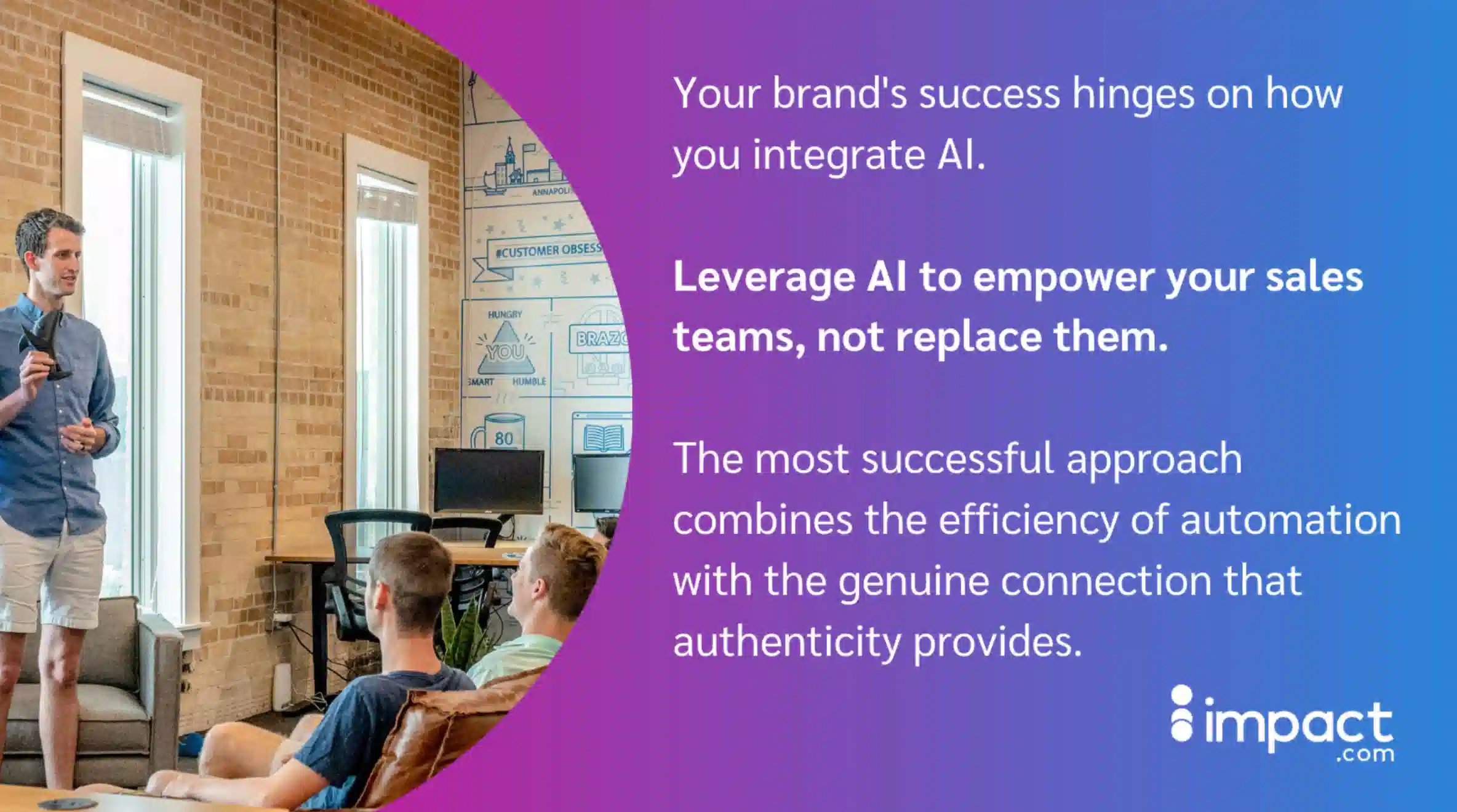
The importance of a privacy-first approach
The shift to LTV is also fundamentally a shift toward data integrity and compliance. As third-party cookies fade and global regulations like GDPR and CCPA tighten, consumers are taking control of their data.
This means that a compliant lead, one that has been legally qualified and whose consent status is transparently tracked, holds significantly more long-term value than a “cheap” lead whose provenance is questionable.
Moore points out that centralized compliance is no longer a niche feature—it’s foundational to growth. “As regulatory pressure increases globally, brands can no longer afford to treat data compliance as an afterthought.”
This focus on privacy builds trust, reduces legal exposure, and ultimately delivers higher-quality customers who feel respected by the brand.
Key takeaway: Invest in platforms that offer automated compliance to future-proof your lead strategy against increasing data regulation.
The economics of lead quality will change
The days of judging success by CPL alone are over. In the next phase of performance marketing, a lead’s value will rely on intent, engagement, and long-term customer value. It’s not just about how much it costs to acquire.
The gap between good and bad leads will only grow wider. Cheap, low-quality leads from mass publishers will quickly lose value. In contrast, high-intent, well-qualified leads from trusted partners will be much more valuable.
Key takeaway: Invest in better measurement and analytics.
Go beyond surface metrics to track:
- Sub-source performance (which specific partners or placements drive results)
- Conversion rates across the funnel
- LTV to see which channels deliver real, lasting revenue
By looking at these metrics, you’ll see which partners boost profitable growth and which ones just add noise to your funnel.
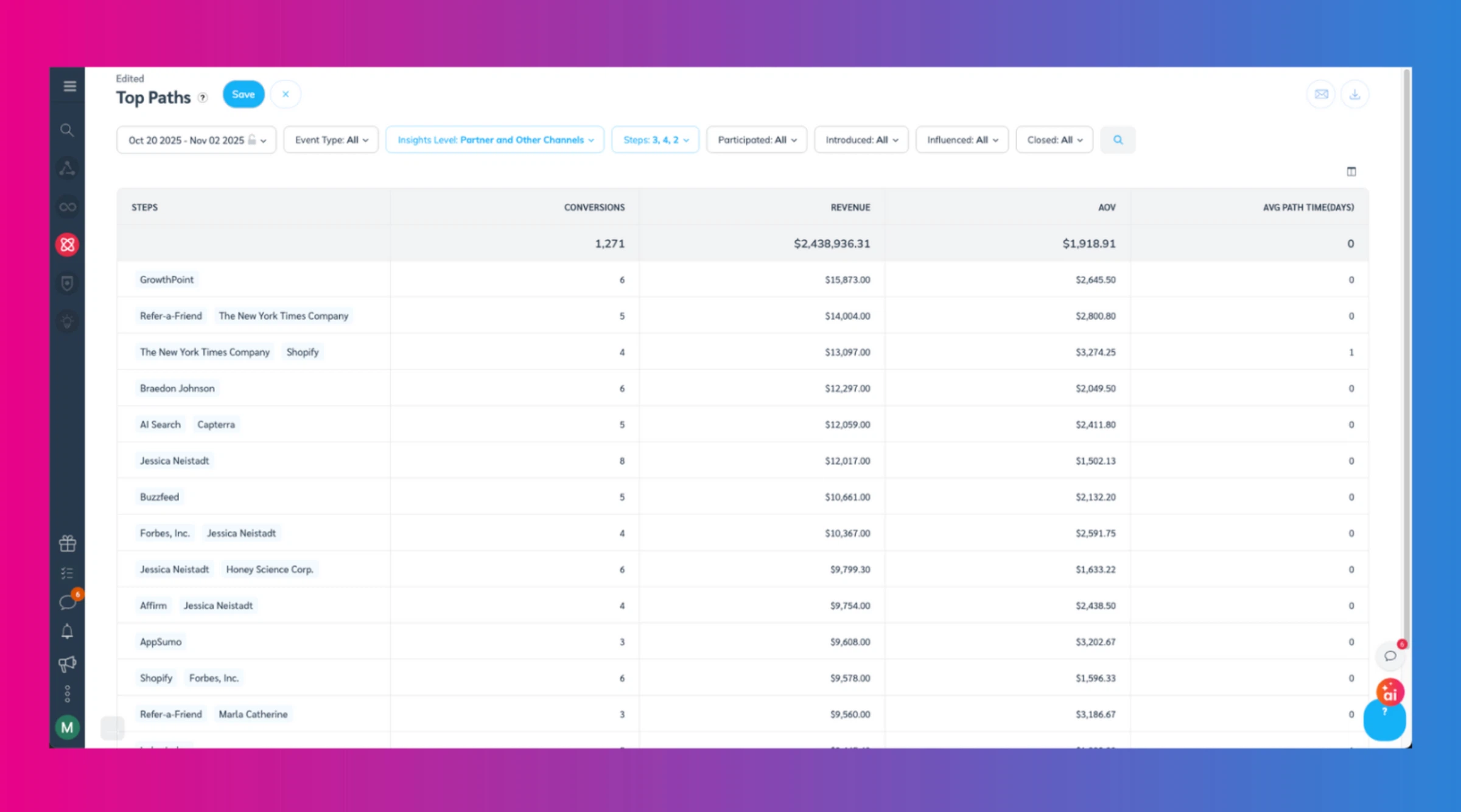
Instantly discover top-performing paths with impact.com. View conversions, revenue, AOV, and more across multiple partners.
3 ways to future-proof your lead generation strategy today
Linder shares three tips your brand should follow to future-proof your strategy.
1. Diversify your channels
Don’t rely on a single source of leads. Partner with a mix of publishers who are experimenting with AI, new discovery methods, and conversational search. A broader mix means more resilience and better-quality leads.
2. Focus on keeping customers
As discovery costs increase, LTV is your key metric. Focus on strategies that encourage customers to return. This includes renewals, upsells, loyalty programmes, and personalised communication.
3. Align your goals across teams
Don’t see affiliate lead generation just as a numbers game. Connect your marketing, data, and growth teams with shared goals. Focus on revenue and retention.
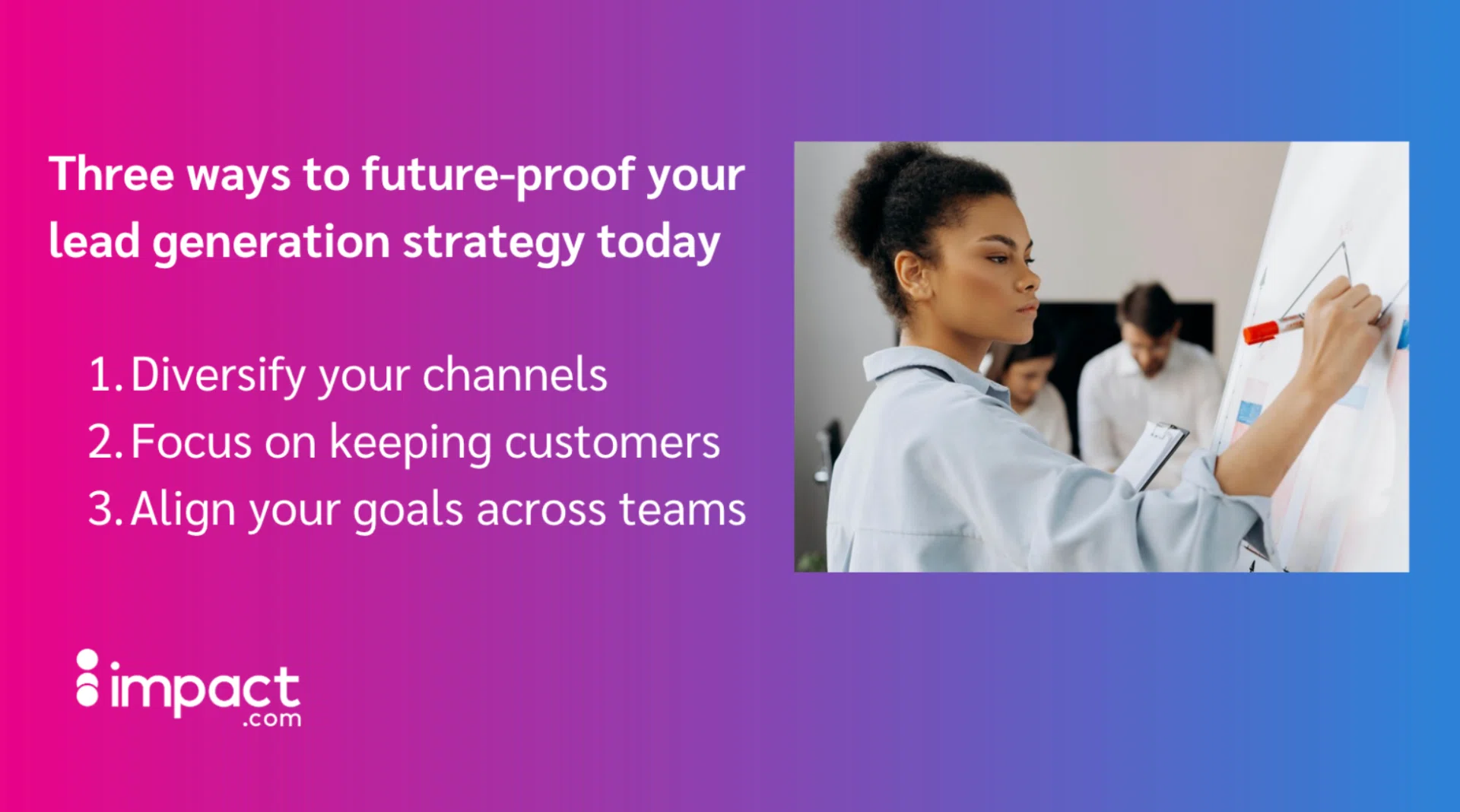
FAQs
Cost per lead (CPL) and customer acquisition costs (CAC) are both marketing metrics, but they measure different stages of the sales funnel.
CPL is the average cost to acquire a potential customer’s contact information, also known as a lead.
CAC is the more comprehensive metric, calculating the total cost to acquire a new, paying customer. It includes all sales and marketing expenses, not just those for lead generation.
Beyond CPL, brands should focus on metrics that connect directly to business growth and retention, such as engagement rates, conversion rates, lifetime value (LTV), and customer retention. These metrics provide a more complete picture of a lead’s true value.
The misconception that all lead publishers are “bad” can cause brands to miss out on valuable partnerships. High-quality publishers add value by pre-screening and qualifying leads upfront, resulting in higher-intent consumers and more efficient marketing spend for the brand.
Technology is a critical partner in the transition to a value-based approach. The right infrastructure, including full-funnel tracking, APIs for real-time lead delivery, and compliance tools, ensures transparency and enables effective optimization of a brand’s lead sources.
AI is already redefining lead generation by reshaping consumer discovery and communication. It will change traffic flows and the types of publishers that succeed, and it will augment how brands qualify and nurture leads. AI is an efficiency tool that allows marketers to focus on the human element of their work.
Brands should start preparing today by investing in measurement that goes beyond CPL, diversifying their acquisition channels, testing AI responsibly, and focusing on retention. The most successful brands in the coming years will be those that align their goals with real business outcomes.
From CPL to LTV: The roadmap to sustainable growth
In a marketing world obsessed with quick wins, it’s easy to chase cheap, high-volume leads and call it success. But as Linder reminds us, that mindset leads to short-term gains and long-term headaches.
The risk: When you focus only on CPL, you’re flying blind, misallocating budget, missing key insights, and celebrating numbers that don’t translate into growth.
The shift: Sustainable success comes from thinking bigger and smarter.
- Measure what matters: Go beyond CPL. Track conversion rates, engagement, and LTV to understand which leads drive profit.
- Connect the dots: Break down silos between marketing, data, and growth teams. Align everyone around the shared goal of acquiring valuable customers, not just more leads.
- Embrace technology and AI: Build the infrastructure that gives you visibility, helps qualify leads faster, and makes smarter optimization possible.
Growth doesn’t come from chasing the cheapest leads. It comes from nurturing the most valuable ones. When you prioritize the lifetime worth of a customer over the short-term cost of acquisition, you’re building a marketing engine that can scale and sustain.
Moore concludes that the core challenge for marketers today is proving that their spending translates to durable revenue. He adds, “That proof requires a platform that doesn’t just calculate CPL, but provides the unified tracking and deep attribution necessary to confidently correlate partner activity to customer lifetime value. That is the definition of a performance marketing engine.”
impact.com provides the comprehensive, full-funnel tracking and compliance automation needed to turn this roadmap into reality, helping your brand confidently shift its investment from lead counting to lasting customer value.
Check out more content here:
- Marketing budget optimization: The performance marketer’s guide to partnership-driven growth [blog]
- 2025 Black Friday consumer report: How brands can prepare for Holiday shopping [research]
- The Partnership Economy podcast: Breaking Marketing Silos with Yulia Shilkina
- Next-gen solution for lead generating partnerships [one sheet]
- Creator marketing attribution models: The modern marketer’s guide in 2025 [blog]





